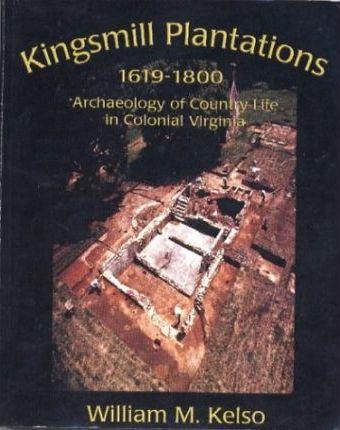Kingsmill Plantation, 1619-1800: Archaeology of Country Life in Colonial Virginia

Kingsmill Plantation, 1619-1800: Archaeology of Country Life in Colonial Virginia
In 1971 William Kelso happened almost by chance on an archaeological find that would open a new door on the rural history of colonial Tidewater Virginia. Erosion had revealed a brick well shaft in a cliff on the James River; above this was an earthen fort and, a bit farther downriver, the remains of a plantation manor. These would be the first of many intriguing discoveries to be made in the area known as Kingsmill. Though the land's owners agreed to cooperate with, and even fund, an archaeological study of the area, the excavation schedule would have to keep one step ahead of the work on a major residential development. For centuries, time had stood still in Kingsmill; now the clock was suddenly ticking. Kingsmill Plantations, Kelso's first-hand account of a great feat of rescue archaeology, covers a three-year period and the excavation of fifteen separate sites. The various properties dated as far back as 1619-placing them among the earliest of American settlements--and continued up through the eighteenth century. Because the division of labor on the Kingsmill Plantations was typical of the era, the settlement could provide an invaluable microcosmic view of colonial Virginia. Meticulous study of the structures and their surroundings--including faunal analyses and inventories of entire house-holds--allowed Kelso and his colleagues to construct a remarkably detailed picture of life in Kingsmill over the course of nearly two hundred years. At once scholarly and highly readable, Kingsmill Plantations speaks to both expert and amateur. An extensive collection of illustrations--including maps, diagrams, and contemporary and archival photographs--makes the narrative especially vivid.
PRP: 123.69 Lei
Acesta este Pretul Recomandat de Producator. Pretul de vanzare al produsului este afisat mai jos.
111.32Lei
111.32Lei
123.69 LeiIndisponibil
Descrierea produsului
In 1971 William Kelso happened almost by chance on an archaeological find that would open a new door on the rural history of colonial Tidewater Virginia. Erosion had revealed a brick well shaft in a cliff on the James River; above this was an earthen fort and, a bit farther downriver, the remains of a plantation manor. These would be the first of many intriguing discoveries to be made in the area known as Kingsmill. Though the land's owners agreed to cooperate with, and even fund, an archaeological study of the area, the excavation schedule would have to keep one step ahead of the work on a major residential development. For centuries, time had stood still in Kingsmill; now the clock was suddenly ticking. Kingsmill Plantations, Kelso's first-hand account of a great feat of rescue archaeology, covers a three-year period and the excavation of fifteen separate sites. The various properties dated as far back as 1619-placing them among the earliest of American settlements--and continued up through the eighteenth century. Because the division of labor on the Kingsmill Plantations was typical of the era, the settlement could provide an invaluable microcosmic view of colonial Virginia. Meticulous study of the structures and their surroundings--including faunal analyses and inventories of entire house-holds--allowed Kelso and his colleagues to construct a remarkably detailed picture of life in Kingsmill over the course of nearly two hundred years. At once scholarly and highly readable, Kingsmill Plantations speaks to both expert and amateur. An extensive collection of illustrations--including maps, diagrams, and contemporary and archival photographs--makes the narrative especially vivid.
Detaliile produsului









